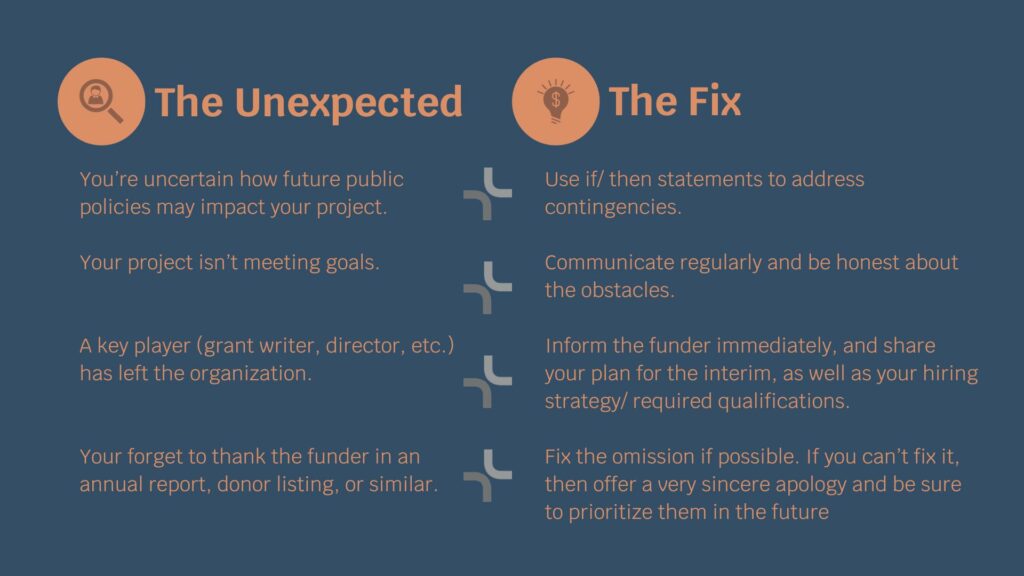Curating a funder prospect list with precision and foresight is more than a clerical task; it’s an opportunity to supercharge your organization’s growth. As we approach the last few months of the year, now is the perfect time to evaluate your grant seeking, assess its performance, and begin building a funder prospect list that will take your results to new heights.
The best way to start is by asking yourself:
How many of your past grant funders repeated their giving in the past year?
How many qualified new grant funding opportunities did you find and pursue?
How many of the grant proposals you submitted were awarded vs. declined?
The simple truth is that if you aren’t hearing “yes” on at least 50 percent of your grant requests, there’s work to be done.
An underperforming grants program is something no organization can afford. It’s critical to take a hard look at what’s happening to ensure you’re directing the right attention, identifying the best prospects, and making the right requests to achieve the best possible outcomes.
Failing to do so is, in fact, a double financial loss – it’s a waste of time and resources that’s spent on other things, and it’s the loss of unrealized grant revenues.
That’s why now, heading into the last quarter of the year, is the best time to build and fortify your grants prospecting plan with an eye towards growth for next year. Our team of grant seeking experts has compiled three core steps for building a high funding prospect list.
Step 1: Love the Ones You’re With
The best first step is to take a careful look at all of your funders from the past two years and create an individualized plan to nurture those relationships. After all, there are no funders more deserving of your attention than those funding you now.
How to get started:
- Identify upcoming due dates for reapplying to past funders.
If you received a grant last year but haven’t yet submitted a new request, immediately look into whether there are remaining deadlines for this year. If so, give the funder a personal phone call or request a meeting to pump some new life into the relationship and find out what direction they have for re-applying.
- Stay up-to-date on changes your past funders have made to their giving.
With every new year, there can be significant adjustments made by funders that affect their grant making. So it’s important to re-visit each of your current funder’s grant guidelines and recent grant awards to stay on top of any changes to their requirements or shifts in their areas of focus. If there are, you’ll want to request a conversation to see if you’re able to evolve together.
- Prioritize your grant report.
If your current funders are requesting a report, don’t miss the deadline. If they’re not, provide a courtesy report anyway as an opportunity to strengthen the relationship by telling the story of their investment in your organization. If things didn’t go as planned, give them the context and information as to why, and what you achieved instead. Here are a few tips on that front:

Step 2: Replenish. Replenish. Replenish.
As idyllic as it would be to keep all of your current funders forever, it’s simply not a realistic strategy. So it’s essential to move ahead with the mindset that revenue from some current funders may eventually drop off, and that new sources of funding will be needed.
Consider this not as a bad thing, but as an opportunity to identify new prospective funders who are closely aligned with your organizational mission, and to begin cultivating those relationships. Use these clues to assess whether a funder is a strong fit:
- What the funder says they care about.
Many funders will describe their areas of funding focus on their website, in their grantmaking guidelines, and in other organizational materials.
- Where the funder has given recently.
The best indicator of whether a funder may be a good fit is by looking at where they’ve given funds before. You can find this out by reviewing their most recent Form 990, and if they’ve made grants to organizations similar to yours, it may be a good fit.

20+ new grant prospects identified and $1.2 million to support youth programming.
Step 3: Prepare Your Action Plan
Once you’ve identified opportunities with new grant funders, put them in a prioritized list and rate your prospects with each using these three criteria:
- Fundamental fit: Complementary mission to your organization’s own; make grants in your geographic area; funds the population(s) you serve.
- Low barrier to entry: Has a defined application process; welcomes unsolicited applications; accepts an initial Letter of Interest (which means less time spent to gauge their interest.)
- Accessibility: Is open to personal contact; makes a program officer available for questions; you have an existing personal connection.
The goal here is putting your grant funding possibilities into some context so that you can make the most informed, realistic choices as to which new funders to prioritize. By devoting the greatest effort to the prospects most likely to become funders, you’ll be on your way to seeing stronger grant revenue returns in the coming year.
With the final months of the year fast approaching, it’s critically important that you take proactive measures when it comes to building and maintaining your funder prospect list. By following these three steps you’ll create an excellent foundation from which to build upon your grant funding success.





